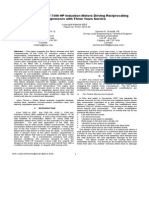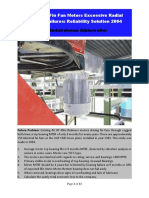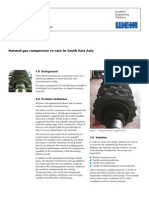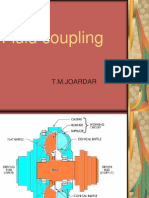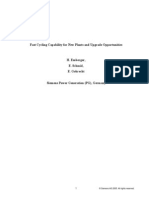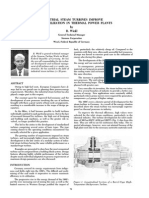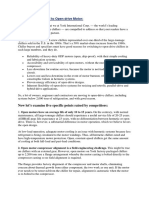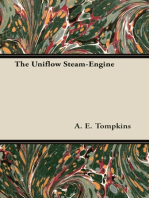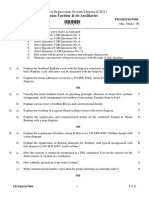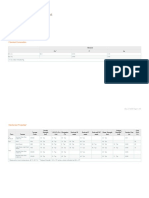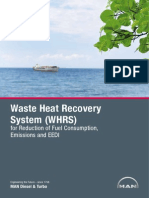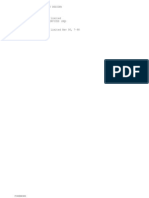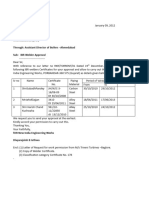Revival of A 50-MW Steam Turbine: After Catastrophic Failure
Revival of A 50-MW Steam Turbine: After Catastrophic Failure
Uploaded by
Hamid MojiryCopyright:
Available Formats
Revival of A 50-MW Steam Turbine: After Catastrophic Failure
Revival of A 50-MW Steam Turbine: After Catastrophic Failure
Uploaded by
Hamid MojiryOriginal Description:
Original Title
Copyright
Available Formats
Share this document
Did you find this document useful?
Is this content inappropriate?
Copyright:
Available Formats
Revival of A 50-MW Steam Turbine: After Catastrophic Failure
Revival of A 50-MW Steam Turbine: After Catastrophic Failure
Uploaded by
Hamid MojiryCopyright:
Available Formats
After Catastrophic Failure
Revival of a 50-MW Steam Turbine
JOHN EAST BOB EISENMANN SULZER TURBOMACHINERY SERVICES Following a severe steam turbine failure, Sulzer Hickham (a subsidiary of Sulzer Turbomachinery Services) provided a cost-effective rebuilt of the turbine rotor and internals. Various elements were redesigned and upgraded during this repair, and start-up assistance was provided. The unit was rebuilt and restarted in record time, and the end user was fully satisfied.
In late 2000, Sulzer Hickham received an order to repair a 1943-vintage, 50-MW steam turbine (Fig. 1). Its configuration consists of a 20-stage, tandem compound double-flow machine with inlet conditions of 60 bar (850 psi) at 500 C (900 F), exhausting to a surface condenser.
A Hopeless Case?
This was the third catastrophic thrust bearing failure since the high-pressure (HP) rotor was renewed in the mid-1980s. The latest failure resulted in severe damage to the rotor and diaphragms. The OEM had declined to repair the HP rotor, and they recommended that the rotor be replaced. In fact,
serious consideration had been given by the end users upper management to dispose of this machinery train. This potential action was predicated on the unreliable operating history of this unit, the high OEM repair costs, and excessive maintenance costs required to keep the unit running. A final evaluation of the economics of the situation dictated that reviving the machine would be cost-effective if sufficient actions could be implemented that would prevent such failures in the future.
Comprehensive Repair
Sulzer Hickhams engineering personnel inspected the machine and its components, and developed an
4052
SULZER TECHNICAL REVIEW 1/2002
1 After having experienced three serious bearing failures, this 50-MW steam turbine has been repaired by Sulzer Hickham.
all-encompassing repair plan that included root cause failure analysis, a rotor dynamics study, reliability upgrades, and HickhamAt-Speed (HAS) balancing in a three-bearing configuration at full speed of 3600 rpm. To prevent future catastrophic failures, a stateof-the-art machinery protection scheme was devised. The end results of these studies included the design and installation of an upgraded thrust and number-one journal bearing, the installation of an improved lube oil filtration system, an electronic governor control system, and a complete Bently Nevada 3500 series machinery protection system per API 670 (a standard of the American Petroleum Institute). Operating procedures were also developed for the machine and were issued to the end user. Field service work was performed by Sulzer Hickham to repair the oil
circulating pumps, correct leaks on the main stop valve, and perform various activities to flush and clean up the oil system. The generator bearings were replaced, and new hydrogen seals were installed. In addition, the turbine control valve assembly and camshafts were properly assembled with new bearings. The valve linkages were connected to the main servo, and all valves were fully stroked and tested. The major turbine repairs were performed on an expedited basis at the Sulzer Hickham shops in La Porte, Texas, USA. This included the welding restoration of four integral turbine disks, the integral thrust collar on the HP rotor, and the replacement of 18 rows of turbine blades and shroud bands. Two of the large, cast iron, lowpressure (LP) diaphragms, which had been condemned during the bid phase by competing shops,
were restored using mechanical inserts designed by Sulzer Hickham. Two HP diaphragms also required inserting, and all remaining diaphragms required significant dressing and/or weld repairs due to rotor rubs.
Vibrations Reduced
During the initial design and historical reviews, Sulzer Hickham learned that a period of almost four years was required by the OEM to get the machine to run when the HP rotor was renewed in the mid-1980s. The reasons for this were not fully appreciated until the start-up attempts in early July 2001. During this start-up, Sulzer Hickhams technical services personnel were on site to monitor and record the vibration, axial position, differential expansion and case expansion transducer signals, along with bearing babbitt temperatures. From that data, it became obvious that the HP rotor was very temperature-sensitive. Variations in the inlet steam conditions would often result in excessive deflection of the HP turbine shaft. In fact, changes in parameters such as turbine growth rate, front standard elevation, exhaust vacuum, or generator load would significantly alter the rotor vibration response.
Special Damper Bearing
In addition, at operating speed, the machine was very close to a critical speed. To further complicate the issue, the surface condenser was rigidly attached to the turbine and was located beneath the number-two bearing, which was inside the LP exhaust hood and surrounded by exhaust steam. This caused the number-two bearing
SULZER TECHNICAL REVIEW 1/2002
elevation (and consequent bearing loads) to vary during start-up due to temperature transients. The HP standard is supported by a 100 cm (40") tall flex-leg and is subject to radiant heat from the casing, so it also resulted in elevation variances at the number-one bearing. The elevation changes of the number-one and -two bearings dramatically affected the vibratory response of the HP rotor. Because of the combination of these factors, initial attempts to counter the shaft deflection with field balance weights were unsuccessful. In an effort to improve the linearity of the rotor response, and therefore permit field balancing, a new Squeeze Film Damper bearing for the HP front standard was designed and supplied by Bearings Plus, Inc., on an expedited basis. Figure 2 outlines the configuration of this patented SFD bearing assembly. In operation, the scroll sections are filled with lube oil, and this provides additional flexibility and damping to the number-one bearing.
3 The rebuilt turbine has been running satisfactorily since August 2001.
Customer Fully Satisfied
The new bearing functioned as expected, and permitted the shaft deflection problem to be brought under control with balance weights. The machine was put online at full load in mid-August 2001 and has run satisfactorily ever since (Fig. 3). During this time period, several nuisance trips have occurred, and in every case, the unit was successfully restarted. The plant operating personnel, some
with over 20 years experience on this machine, commented that the turbine had never run so smoothly. The combination of the latest technology and experienced Sulzer Hickham personnel allowed the start-up phase of the machine to be reduced to a small fraction of that required in the mid-1980s, and resulted in a reliable long-term source of power generation for the plant.
2 By the use of a special damper bearing, the effects of a critical speed could be alleviated.
CONTACT
Hickham Industries Inc. John East 11518 Old La Porte Rd La Porte, TX 77571 USA Phone +1 (1)713-567 27 72 Fax +1 (1)713-567 28 30 E-mail john.east@hickham.com
SULZER TECHNICAL REVIEW 1/2002
You might also like
- How to Rebuild & Modify Rochester Quadrajet CarburetorsFrom EverandHow to Rebuild & Modify Rochester Quadrajet CarburetorsRating: 5 out of 5 stars5/5 (2)
- XJS 3.6 Service EngineDocument192 pagesXJS 3.6 Service Enginessinokrot100% (1)
- Overhauling Report Unit#2 2020 FinalDocument52 pagesOverhauling Report Unit#2 2020 FinalJhajjar100% (2)
- 160 MW Steam Turbine Repair Project: Delivering High-Quality Service On A Tight ScheduleDocument3 pages160 MW Steam Turbine Repair Project: Delivering High-Quality Service On A Tight Schedulerashm006ranjan100% (1)
- Radial Inflow Turboexpander Redesign Steamboat Geothermal Power Plants I/IA - Reno, Nevada Brad Platt, Project ManagerDocument4 pagesRadial Inflow Turboexpander Redesign Steamboat Geothermal Power Plants I/IA - Reno, Nevada Brad Platt, Project Managerrcarpioo100% (1)
- Maintenance Contract at Fertilizer Plant: Sulzer Turbo-Machinery ServicesDocument3 pagesMaintenance Contract at Fertilizer Plant: Sulzer Turbo-Machinery ServicesAkhil AklNo ratings yet
- Failure Analysis of 7500 HP MotorDocument6 pagesFailure Analysis of 7500 HP Motorgusgif100% (1)
- Root Cause Failure Analysis Gas Plant Fin Fan Motor Bearings ImprovementDocument11 pagesRoot Cause Failure Analysis Gas Plant Fin Fan Motor Bearings ImprovementAbdulrahman AlkhowaiterNo ratings yet
- Aeroderivative Gas Turbine Analysis and TestDocument4 pagesAeroderivative Gas Turbine Analysis and TestJorge Mario RodriguezNo ratings yet
- Improved Power Plant PerformanceDocument3 pagesImproved Power Plant Performanceshams100% (2)
- Canned Motor Pumps in Refinery PDFDocument2 pagesCanned Motor Pumps in Refinery PDFthawdarNo ratings yet
- Re-Rate Case StudyDocument4 pagesRe-Rate Case StudyA_MosbahNo ratings yet
- I A G T C: Ndustrial Pplication OF AS Urbines OmmitteeDocument13 pagesI A G T C: Ndustrial Pplication OF AS Urbines Ommittee'Izzad Afif100% (1)
- Pipe Strain: 50 OrbitDocument11 pagesPipe Strain: 50 Orbitsaadbakhtyar2065No ratings yet
- TurboTalk Vol11Document12 pagesTurboTalk Vol11Prastowo PriyatmokoNo ratings yet
- New Seals Solve Vibration Problem: Sulzer Turbo ServicesDocument3 pagesNew Seals Solve Vibration Problem: Sulzer Turbo ServicesHamid MojiryNo ratings yet
- Ethane 1800 KW Turbo-Expander Reliability Improvement: Vibration & DGS Seal FailuresDocument18 pagesEthane 1800 KW Turbo-Expander Reliability Improvement: Vibration & DGS Seal Failuressanjeevvange100% (1)
- Suzler Large Steam TurbineDocument3 pagesSuzler Large Steam Turbineramnadh803181100% (1)
- Evaluation of Tilting Pad Thrust BearingsDocument10 pagesEvaluation of Tilting Pad Thrust BearingsChristopher Garcia0% (1)
- Resolving Bearing Failures of Refinery 200 KW Fan-MotorDocument7 pagesResolving Bearing Failures of Refinery 200 KW Fan-MotorCesar SampaioNo ratings yet
- Simpson - Boiler Feed Pump Turbine Case StudyDocument11 pagesSimpson - Boiler Feed Pump Turbine Case Studyvinothenergy100% (1)
- 1977 - Wildman - Developments in Steam TurbinesDocument6 pages1977 - Wildman - Developments in Steam TurbinesManoj Kumar100% (1)
- Flywheel Culham pre-CCFE-PR1728Document9 pagesFlywheel Culham pre-CCFE-PR1728milkoNo ratings yet
- Steam Turbine For PumpsDocument10 pagesSteam Turbine For PumpsRajesh Krishnamoorthy100% (1)
- Improving The Reliability of Turbine Lube Oil SupplyDocument11 pagesImproving The Reliability of Turbine Lube Oil SupplyWAN NOURUL AINNA A.No ratings yet
- Hydro Media Media Center Iron Gates eDocument16 pagesHydro Media Media Center Iron Gates eShweta SankhlaNo ratings yet
- Steam Turbine DatasheetDocument2 pagesSteam Turbine Datasheet김대우100% (2)
- 46 EB9 CFFD 01Document11 pages46 EB9 CFFD 01agmateoNo ratings yet
- Free Piston Stirling 7kwDocument8 pagesFree Piston Stirling 7kwmikialeNo ratings yet
- Turbine MaintainanceDocument9 pagesTurbine Maintainanceer_sanjaypatel100% (2)
- Fluid Coupling: T.M.JoardarDocument43 pagesFluid Coupling: T.M.JoardarKuntal Satpathi50% (2)
- Crankshaft Replacement & Engine Overhaul and Rebuild For Royal Saudi Air Force Power StationDocument2 pagesCrankshaft Replacement & Engine Overhaul and Rebuild For Royal Saudi Air Force Power StationAlaa IslamNo ratings yet
- Turboexpander-Compressor Technology For Ethylene Plants: GE Oil & GasDocument12 pagesTurboexpander-Compressor Technology For Ethylene Plants: GE Oil & Gaspatrickzluo100% (1)
- Problem in Steam Turbine LubricationDocument8 pagesProblem in Steam Turbine LubricationmishraenggNo ratings yet
- Genco IiiDocument45 pagesGenco IiiRamnadh Mandali100% (1)
- 3 Q 00 DimondDocument4 pages3 Q 00 Dimondhosein30No ratings yet
- Getting The Oil To The Shore: High-Pressure Pumps For High-Viscosity FluidsDocument4 pagesGetting The Oil To The Shore: High-Pressure Pumps For High-Viscosity FluidsfabrcadNo ratings yet
- 1982 - Korner - Design Features of Steam PDFDocument6 pages1982 - Korner - Design Features of Steam PDFramakantinamdarNo ratings yet
- GE Hydro Thrust BearingsDocument3 pagesGE Hydro Thrust BearingsJesusMaldonado0% (1)
- 4 Fast Cycling CapabilityDocument13 pages4 Fast Cycling CapabilityktsnlNo ratings yet
- Tutorial On Turbo ExpanderDocument0 pagesTutorial On Turbo ExpanderMajid Sattar100% (1)
- Hot Spots in Turboexpander Bearings: Case History, Stability Analysis, Measurements and Operational ExperienceDocument11 pagesHot Spots in Turboexpander Bearings: Case History, Stability Analysis, Measurements and Operational Experienceelbusharieltaher1261100% (1)
- Train 7 Fire Incident at The Petronas LNG ComplexDocument8 pagesTrain 7 Fire Incident at The Petronas LNG ComplexAmroKashtNo ratings yet
- Service Bulletin: Subject: Taurus Engine Rotor Lock-Up During Hot RestartDocument8 pagesService Bulletin: Subject: Taurus Engine Rotor Lock-Up During Hot RestartKhalifaNo ratings yet
- 141 Small Gas Turbine Engine Operating With High Temperature Foil Bearings AbstractDocument1 page141 Small Gas Turbine Engine Operating With High Temperature Foil Bearings Abstractkats2404100% (1)
- Troubleshooting Turbine SystemsDocument74 pagesTroubleshooting Turbine Systemsdaaanb100% (1)
- Industrial Steam Turbines Improve Energy Utilization in Thermal Power Plants by R. WicklDocument8 pagesIndustrial Steam Turbines Improve Energy Utilization in Thermal Power Plants by R. WickljnmanivannanmechNo ratings yet
- Medium and Highspeed Diesel Engines For Marine Service 1938Document11 pagesMedium and Highspeed Diesel Engines For Marine Service 1938Merrel RossNo ratings yet
- Why YORK Switched To Open Drive Motor:: Now Let's Examine Five Specific Points Raised by CompetitorsDocument15 pagesWhy YORK Switched To Open Drive Motor:: Now Let's Examine Five Specific Points Raised by CompetitorsImran GhafoorNo ratings yet
- Kal War 2017Document10 pagesKal War 2017khusnul9No ratings yet
- Twin Lobe CompressorDocument14 pagesTwin Lobe Compressorpbs9890271109100% (1)
- Bhel PresentationDocument31 pagesBhel PresentationSamuel Bhukya100% (1)
- Turbo Tech 102 PDFDocument7 pagesTurbo Tech 102 PDFPetar PavićNo ratings yet
- Gas-Engines and Producer-Gas Plants A Practice Treatise Setting Forth the Principles of Gas-Engines and Producer Design, the Selection and Installation of an Engine, Conditions of Perfect Operation, Producer-Gas Engines and Their Possibilities, the Care of Gas-Engines and Producer-Gas Plants, with a Chapter on Volatile Hydrocarbon and Oil EnginesFrom EverandGas-Engines and Producer-Gas Plants A Practice Treatise Setting Forth the Principles of Gas-Engines and Producer Design, the Selection and Installation of an Engine, Conditions of Perfect Operation, Producer-Gas Engines and Their Possibilities, the Care of Gas-Engines and Producer-Gas Plants, with a Chapter on Volatile Hydrocarbon and Oil EnginesNo ratings yet
- How to Power Tune the BMC/BL/Rover 998 A-Series Engine for Road and TrackFrom EverandHow to Power Tune the BMC/BL/Rover 998 A-Series Engine for Road and TrackNo ratings yet
- Plymouth and Chrysler-built cars Complete Owner's Handbook of Repair and MaintenanceFrom EverandPlymouth and Chrysler-built cars Complete Owner's Handbook of Repair and MaintenanceNo ratings yet
- Construction and Manufacture of AutomobilesFrom EverandConstruction and Manufacture of AutomobilesRating: 5 out of 5 stars5/5 (1)
- Symbolic Solutions For A Class of Partial Differential EquationsDocument10 pagesSymbolic Solutions For A Class of Partial Differential EquationsHamid MojiryNo ratings yet
- 337 345 PDFDocument9 pages337 345 PDFHamid MojiryNo ratings yet
- v2 PDFDocument20 pagesv2 PDFHamid MojiryNo ratings yet
- Solution of Nonlinear Oscillators Using Global Error Minimization MethodDocument8 pagesSolution of Nonlinear Oscillators Using Global Error Minimization MethodHamid MojiryNo ratings yet
- Analytical Probability Density Functions For Lms Adaptive Filters Using The Fokker-Planck EquationDocument4 pagesAnalytical Probability Density Functions For Lms Adaptive Filters Using The Fokker-Planck EquationHamid MojiryNo ratings yet
- The Solution of Second-Order Partial Differential EquationsDocument121 pagesThe Solution of Second-Order Partial Differential EquationsHamid MojiryNo ratings yet
- Pure Soliton Solutions of Some Nonlinear Partial Differential EquationsDocument8 pagesPure Soliton Solutions of Some Nonlinear Partial Differential EquationsHamid MojiryNo ratings yet
- A Subclass of Quasi Self Adjoint Lubrication Equations: Conservations LawsDocument8 pagesA Subclass of Quasi Self Adjoint Lubrication Equations: Conservations LawsHamid MojiryNo ratings yet
- High Order Discontinuous Galerkin Method For Elastohydrodynamic Lubrication Line Contact ProblemsDocument7 pagesHigh Order Discontinuous Galerkin Method For Elastohydrodynamic Lubrication Line Contact ProblemsHamid MojiryNo ratings yet
- A Numerical Scheme For Unsteady Flow of A Viscous Fluid Between Elliptic PlatesDocument5 pagesA Numerical Scheme For Unsteady Flow of A Viscous Fluid Between Elliptic PlatesHamid MojiryNo ratings yet
- Prod CoursesofstudyDocument26 pagesProd CoursesofstudyHamid MojiryNo ratings yet
- A Cartesian Grid Method For Solving The Two-Dimensional Streamfunction-Vorticity Equations in Irregular RegionsDocument45 pagesA Cartesian Grid Method For Solving The Two-Dimensional Streamfunction-Vorticity Equations in Irregular RegionsHamid MojiryNo ratings yet
- MSP 3407D, MSP 3417D Multistandard Sound Processors: MicronasDocument60 pagesMSP 3407D, MSP 3417D Multistandard Sound Processors: MicronasHamid MojiryNo ratings yet
- M. Tech. Computer Aided DesignDocument42 pagesM. Tech. Computer Aided DesignHamid MojiryNo ratings yet
- Ding-Shu (JCP 2005)Document24 pagesDing-Shu (JCP 2005)Hamid MojiryNo ratings yet
- Efficient Numerical Method For Computation of Thermohydrodynamics of Laminar Lubricating FilmsDocument25 pagesEfficient Numerical Method For Computation of Thermohydrodynamics of Laminar Lubricating FilmsHamid MojiryNo ratings yet
- A Generalized Differential Quadrature Solution For Laminated Composite Shells of RevolutionDocument2 pagesA Generalized Differential Quadrature Solution For Laminated Composite Shells of RevolutionHamid MojiryNo ratings yet
- Journal of Computational Physics: J. Wu, C. ShuDocument21 pagesJournal of Computational Physics: J. Wu, C. ShuHamid MojiryNo ratings yet
- Methods Based On The Differential Quadrature in Vibration Analysis of PlatesDocument17 pagesMethods Based On The Differential Quadrature in Vibration Analysis of PlatesHamid MojiryNo ratings yet
- Determination of Moisture Content (AOAC, 1999)Document0 pagesDetermination of Moisture Content (AOAC, 1999)Hamid MojiryNo ratings yet
- The Backward-Tracking Lagrangian Particle Method For Transient Viscoelastic FlowsDocument34 pagesThe Backward-Tracking Lagrangian Particle Method For Transient Viscoelastic FlowsHamid MojiryNo ratings yet
- IntroDocument28 pagesIntroHamid MojiryNo ratings yet
- CH 09 Part SolutionDocument10 pagesCH 09 Part SolutionHamid MojiryNo ratings yet
- Chen - Shu Et Al (Computers & Structures) 2000Document12 pagesChen - Shu Et Al (Computers & Structures) 2000Hamid MojiryNo ratings yet
- Steam Turbine & Its Auxiliaries: B.E. (Power Engineering) Seventh Semester (C.B.S.)Document2 pagesSteam Turbine & Its Auxiliaries: B.E. (Power Engineering) Seventh Semester (C.B.S.)SylvesterNo ratings yet
- Copper Alloy C14200 PDFDocument9 pagesCopper Alloy C14200 PDFNut AssanaiNo ratings yet
- Manual Operacion Hoshizaki Modelo KM-650 - InstDocument42 pagesManual Operacion Hoshizaki Modelo KM-650 - Instchristopher menesesNo ratings yet
- A Successful Approach To Improve Energy Utilization in Ethylene Units - 2007 - 91fDocument65 pagesA Successful Approach To Improve Energy Utilization in Ethylene Units - 2007 - 91fMahsa100% (1)
- Attachment 3 - G390E7sw00 - (1+1)Document21 pagesAttachment 3 - G390E7sw00 - (1+1)4nagNo ratings yet
- Precheck Before Light-Up: Drum Metal Temp. DiffDocument12 pagesPrecheck Before Light-Up: Drum Metal Temp. DiffAhemadNo ratings yet
- HRSGDocument36 pagesHRSGDumitrescu100% (1)
- Operation and Protection of 210 MW Turbine Condensation Extracton Pump and Condensation CycleDocument31 pagesOperation and Protection of 210 MW Turbine Condensation Extracton Pump and Condensation CycleAshish Lanjewar100% (3)
- Waste Heat Recovery System For Cement PlantDocument6 pagesWaste Heat Recovery System For Cement PlantandrowreganNo ratings yet
- Escon Final ReportDocument9 pagesEscon Final ReportAzmi NdtNo ratings yet
- Gland Sealing Systeam011Document6 pagesGland Sealing Systeam011Sonrat100% (2)
- Orion Airdryer RAXDocument100 pagesOrion Airdryer RAXNguyễn Xuân Điệp67% (3)
- EC - I MCQ Question Bank On Unit 5 & 6-1Document12 pagesEC - I MCQ Question Bank On Unit 5 & 6-1Harshad jambhaleNo ratings yet
- ACC LimitedDocument8 pagesACC LimitedRohit Vishal PandeyNo ratings yet
- Manitowoc S400 (EN)Document64 pagesManitowoc S400 (EN)VicNo ratings yet
- Körting Non-Metallic Vacuum SystemsDocument8 pagesKörting Non-Metallic Vacuum SystemsMuhammad Nur ShidiqNo ratings yet
- Doucette Industries, IncDocument12 pagesDoucette Industries, IncPablo PasqualiniNo ratings yet
- JKM Company Profile NewDocument10 pagesJKM Company Profile NewHariom GuptaNo ratings yet
- WH Vacuum in Steam TurbineDocument2 pagesWH Vacuum in Steam Turbinemiths_0087100% (2)
- STGDocument12 pagesSTGLiji Brijesh100% (2)
- 002-Steam Turbines Basics For BeginnersDocument10 pages002-Steam Turbines Basics For BeginnersGeorge J Alukkal100% (1)
- Waste Heat Recovery SystemDocument32 pagesWaste Heat Recovery Systemvran77No ratings yet
- Condensate SystemDocument1 pageCondensate SystemAkhilesh VijayaKumarNo ratings yet
- Emergency Actions Code:Btpp/Turbine/011/Emergency Actions A.Actions To Be Taken in Case of Both CW Pumps TrippingDocument4 pagesEmergency Actions Code:Btpp/Turbine/011/Emergency Actions A.Actions To Be Taken in Case of Both CW Pumps TrippingPrakash ChoudharyNo ratings yet
- Efficiency of Geothermal Power Plants - A Worldwide Review-AzDocument13 pagesEfficiency of Geothermal Power Plants - A Worldwide Review-Azbitconcepts9781No ratings yet
- Turbine ErectionDocument130 pagesTurbine Erectionkarthikgoldenrock100% (1)
- High-Powered Air-Cooled Condensers: Fast Installation, Reliable OperationDocument4 pagesHigh-Powered Air-Cooled Condensers: Fast Installation, Reliable OperationDoel Biasa AjahNo ratings yet
- Boiler Permission LetterDocument80 pagesBoiler Permission Letterruturajsinh6026No ratings yet
- Maintenance of Turbine Lubrication System and CondenserDocument26 pagesMaintenance of Turbine Lubrication System and CondenserAshwani Dogra100% (1)






